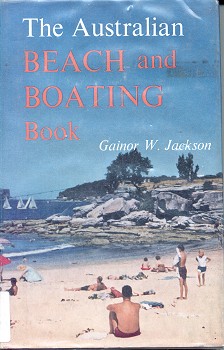surfresearch.com.au
 |
surfresearch.com.au
jackson : riding the rollers,
1963
|
Gainor Jackson : Riding
the Rollers, 1963.
Extract
from
Jackson, Gainor W.: The
Australian
Beach and Boating Book.
Cassell Australia, 210 Queen Street
Melbourne,
Victoria, 1963.
Introduction.
A very basic
overview
of surfboard riding.
Note the lower
price
for the, now superseded, balsa boards and the longer length of
the current
foam boards.
Jackson was an
experienced yachtsman
Page
75
Riding
the Rollers on Surfboard
Australia is
one of the great surfing paradises of the world.
Hundreds
ride
the rollers at Manly and Bondi every summer week-end that
the surf is in.
You will see
them also at Catherine Hill, Crescent Head, Voodoo, or
Boneyard Bay, among
many other beaches.
A foam
plastic
surfboard will cost maybe £40 and a good secondhand one from
between
£15 to £25.
Be careful
when
buying old foam boards, since many are weakened with
bubbles.
Balsa wood
boards,
once very popular, are cheaper, and might be bought
secondhand for about
£5 to £18.
Old Balsa
boards
are usually shorter in length than is common today, but they
are quite
satisfactory on the down-hill run. Nowadays boards average
about 9 feet
to 10 feet in length, and bigger boards are used for the
giant waves.
It is usual
to
rub a board regularly with paraffin wax to prevent it
becoming too slippery.
So now you
have
the board and are ready to learn to ride it.
To paddle
out
you should lie or kneel on the board so that it floats
evenly.
Use strong
and
even strokes, and these will eventually take you through the
breaking waves
to the clearer water beyond.
Wait a
little
before attempting a run, and have a look at the wave
formations and where
they begin to break.
Let the
first
one ...
Page 76
... go
(they usually
come in groups of two or three), since this will deepen and
calm the water
inshore.
Turn the
board
toward the shore, paddling steadily, and let the wave come
at you from
dead astern.
Slowly at
first
the board will begin to lift and run down the front swell.
Now is the
big
moment to stand up smoothly with one foot ahead of the other
and knees
bent.
Stand on the
board at a point about two-thirds of its length from the
front.
Adjust your
weight
through the knees, arms and the slope of your body.
It is usual
to
lean slightly forward with one shoulder leading.
Directional
changes
are made (much as they would be in snow ski-ing) by altering
the direction
of your shoulder and transmitting the twist through a
somewhat stiffened
torso.
It is wiser
to
try straight runs first until you get the feel of it.
The surf
differs
in average size from one beach to another.
Sydney surf
is
usually not as big, for example, as in some country areas.
If the surf
is
big, be very cautious, especially if you are a beginner.
Study the
way
the waves come in, and study them for at least fifteen
minutes before paddling
out.
Finally, if
you
get 'rolled in' under a big wave try to struggle up as
quickly as possible
to the surface.
All in all
it
is a great sport, thrilling, healthy, and spectacular.

A typical
poly-ether
fibreglass covered surfboard

|
Jackson, Gainor
W.:
The Australian Beach and
Boating Book.
Cassell Australia,
210 Queen Street Melbourne,
Victoria,
1963.
|

surfresearch.com.au
Geoff Cater (2011-2018) :
Gainor Jackson
: Riding the Rollers, 1963.
http://www.surfresearch.com.au/1963_Jackson_Aust_Beach_Boating.html


